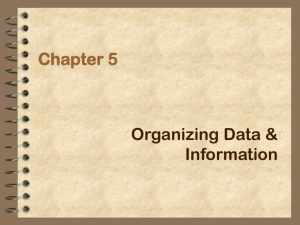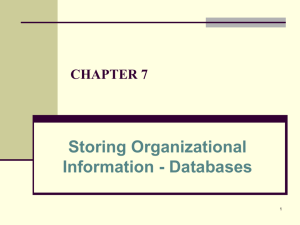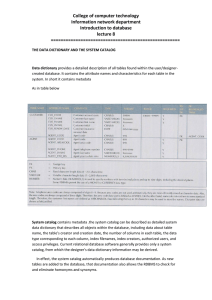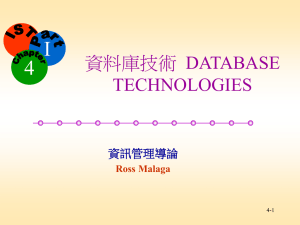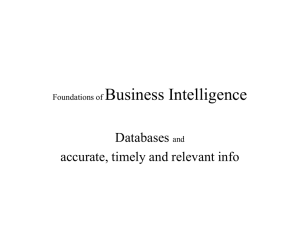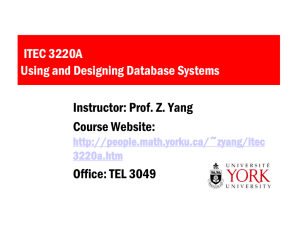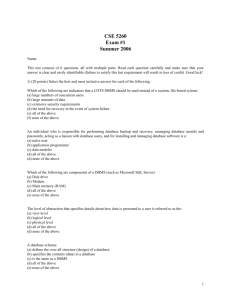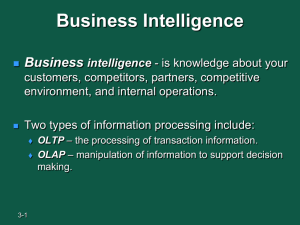Organizing Data and Information
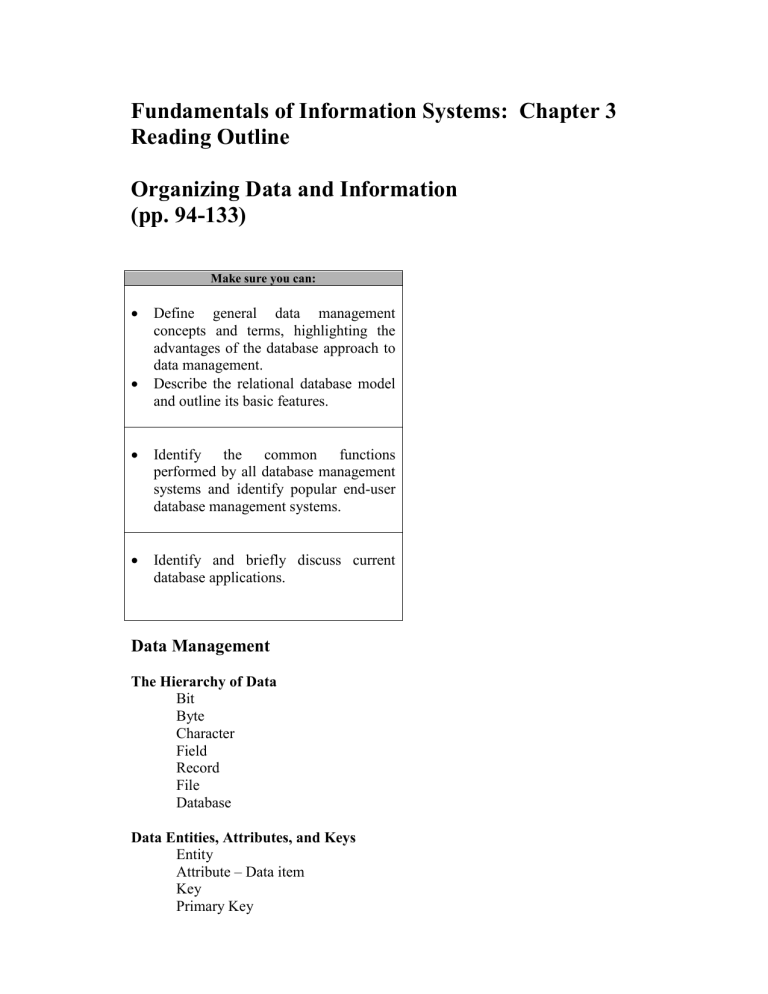
Fundamentals of Information Systems: Chapter 3
Reading Outline
Organizing Data and Information
(pp. 94-133)
Make sure you can:
Define general data management concepts and terms, highlighting the advantages of the database approach to data management.
Describe the relational database model and outline its basic features.
Identify the common functions performed by all database management systems and identify popular end-user database management systems.
Identify and briefly discuss current database applications.
Data Management
The Hierarchy of Data
Bit
Byte
Character
Field
Record
File
Database
Data Entities, Attributes, and Keys
Entity
Attribute – Data item
Key
Primary Key
The Traditional Approach Versus the Database Approach
Traditional Approach
Data redundancy
Database Approach
Data integrity
Database Management System (dbms)
Advantages of database approach
Disadvantages of database approach
Data Modeling and the Relational Database Model
Data Modeling
Data model
Enterprise data modeling
Entity-relationship diagrams
The Relational Database Model
Relational Model
Tables – Relations
Row – Data entity
Column – Attribute
Manipulating Data
Selecting
Projecting
Joining
Linking tables
Database Management Systems (DBMSs)
Overview of Database Types
Flat File
Single User
Multiple Users
Basic
DBMS
Functions:
Providing user views (schema, subschema)
Creating and modifying databases (data definition language (ddl), data dictionary)
Storing and retrieving data (logical and physical access paths)
Manipulating data (data manipulation language (dml), structured query language (sql)
Generating reports
Database Administration
Selecting a Database Management System
Database size
Number of concurrent users
Performance
Integration
Features
The vendor
Cost
Using Databases with Other Software
Database Applications
Linking the Company Database to the Internet
Data Warehouses
Data Marts
Data Mining
Business Intelligence
Knowledge management
Online analytical processing (OLAP)
Understand differences between data mining and olap
Distributed Database
Visual, Audio, and Other Database Systems
Key Terms
Attribute: A characteristic of an entity
Business intelligence (BI): The process of gathering enough of the right information in a timely manner and usable form and analyzing it to have a positive impact on business strategy, tactics, or operations
Character: A basic building block of information, consisting of uppercase letters, lowercase letters, numeric digits, or special symbols
Competitive intelligence: A continuous process involving the legal and ethical collection of information about competitors, its analysis, and controlled dissemination of information to decision makers
Concurrency control: A method of dealing with a situation in which two or more people need to access the same record in a database at the same time
Counterintelligence: The steps an organization takes to protect information sought by
“hostile” intelligence gatherers
Data definition language (DDL): A collection of instructions and commands used to define and describe data and data relationships in a specific database
Data dictionary: A detailed description of all data used in the database
Data integrity: The degree to which the data in any one file is accurate
Data item: The specific value of an attribute
Data manipulation language (DML): The commands that are used to manipulate the data in a database
Data mart: A subset of a data warehouse
Data mining: An information-analysis tool that involves the automated discovery of patterns and relationships in a data warehouse or data mart
Data model: A diagram of entities and their relationships
Data redundancy: A duplication of data in separate files
Data warehouse: A database that collects business information from many sources in the enterprise, covering all aspects of the company’s processes, products, and customers
Database administrator (DBA): A skilled IS professional who directs all activities related to an organization’s database
Database approach to data management: An approach whereby a pool of related data is shared by multiple application programs
Database management system (DBMS): A group of programs that manipulate the database and provide an interface between the database and its users and other application programs
Distributed database: A database in which the data can be spread across several smaller databases connected via telecommunications devices
Domain: The allowable values for data attributes
Enterprise data modeling: The data modeling done at the level of the entire enterprise
Entity: A generalized class of people, places, or things for which data is collected, stored, and maintained
Entity-relationship (ER) diagram: The data models that use basic graphical symbols to show the organization of and relationships between data
Field: Typically a name, number, or combination of characters that describes an aspect of a business object or activity
File: A collection of related records
Hierarchy of data: Bits, characters, fields, records, files, and databases
Joining: The data manipulation that combines two or more tables
Key: A field or set of fields in a record that is used to identify the record
Knowledge management: The process of capturing a company’s collective expertise wherever it resides—in computers, on paper, in people’s heads—and distributing it wherever it can help produce the biggest payoff
Linking: The data manipulation that relates or links two or more tables using common data attributes
Object-oriented database: The database that stores both data and its processing instructions
Object-oriented database management system (OODBMS): A group of programs that manipulate an object-oriented database and provide a user interface and connections to other application programs
Object-relational database management system (ORDBMS): A DBMS capable of manipulating audio, video, and graphical data
Online analytical processing (OLAP): The software that allows users to explore data from a number of different perspectives
Planned data redundancy: A way of organizing data in which the logical database design is altered so that certain data entities are combined, summary totals are carried in the data records rather than calculated from elemental data, and some data attributes are repeated in more than one data entity to improve database performance
Predictive analysis: A form of data mining that combines historical data with assumptions about future conditions to predict outcomes of events, such as future product sales or the probability that a customer will default on a loan
Primary key: A field or set of fields that uniquely identifies the record
Projecting: The data manipulation that eliminates columns in a table
Record: A collection of related data fields
Relational model: A database model that describes data in which all data elements are placed in two-dimensional tables, called relations, which are the logical equivalent of files
Replicated database: A database that holds a duplicate set of frequently used data
Schema: A description of the entire database
Selecting: The data manipulation that eliminates rows according to certain criteria
Subschema: A file that contains a description of a subset of the database and identifies which users can view and modify the data items in the subset
Traditional approach to data management: An approach whereby separate data files are created and stored for each application program

